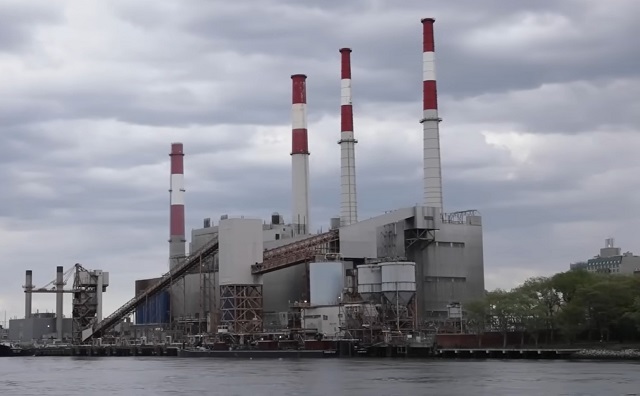Energy
Biden’s Mad War On Natural Gas Will Not End Well For Americans

 From the Daily Caller News Foundation
From the Daily Caller News Foundation
Even as the Biden administration’s regulatory agencies are moving to render the building of new natural gas power plants too costly to justify, a consensus has formed in the analyst community that the added power demands from AI will require a big expansion of natural gas generation to ensure grid stability.
Over a span of less than 20 days in April and May, Biden regulators at the Environmental Protection Agency(EPA) and the Federal Energy Regulatory Commission(FERC) published new regulations that, according to grid expert Robert Bryce, add more than 1 million words targeting natural gas to the federal register.
On April 25, the EPA finalized new power plant emission rules that will essentially force the retirement of America’s remaining coal-fired power plants by 2030 by rendering them too costly to continue operating. Most media reports focused on that aspect of the new regulations, which had been anticipated.
Reporters gave less attention to the fact that the new rules also constitute a clear effort to make it nearly impossible to finance and operate additional gas-fired power plants over the same time. The requirement that new gas plants be accompanied by costly carbon capture and storage (CCS) capability adds millions in additional costs and would also consume as much as 30% of the power generated by the plants, greatly diminishing their profitability. The fact that some operators have already tried and failed to add CCS to at least five such plants in the United States leads to an almost inevitable conclusion that this rule is intentionally structured to shut down the natural gas power industry in this country.
On May 13, the FERC rules added hundreds of thousands of more words targeting natural gas with its Order 1920. Where the EPA rules make it vastly more expensive to build and operate natural gas power plants, FERC Order 1920 makes it more costly and difficult to permit transmission lines needed to carry their electricity to market. FERC does this by discriminating between generation sources, streamlining and incentivizing permitting for power lines that are connected to wind and solar projects.
It is a regulatory pincer move designed to force generation companies to invest in wind and solar to the exclusion of natural gas generation, one that Bryce says “will strangle AI in the crib.” Rapidly expanding power loads will require a generation source that is reliable 24 hours, seven days each week, one that can be rapidly dispatched to meet demand surges that take place every day. Only natural gas can reliably fill that breach.
A series of recently published analytical studies support Bryce’s case. A Goldman Sachs analysis published in mid-May estimates that natural gas is the most fit generation tech to meet about 60% of the incremental demand load by 2030. Tudor Pickering & Holt estimates that meeting the new demand could require the building of as much as 8.5 bcf/day of new natural gas generation capacity over the same time frame.
Bryce quotes from a Morningstar report that pegs the additional gas demand at 7 to 10 bcf/day. He also refers to an Enverus study that concludes that power demand from AI and other data centers will double by 2035, requiring an additional 4.2 bcf/day of new natural gas generation by that time for their needs alone.
“This type of need demonstrates that the emphasis on renewables as the only source of power is fatally flawed in terms of meeting the real demands of the market,” Richard Kinder, executive chairman of pipeline operator Kinder Morgan, told analysts during the company’s first-quarter earnings in April, as reported by CNBC.
Seldom do we see a consensus so broad and diverse as this emerge on any topic in the energy space, yet the Biden regulators at EPA, FERC and other relevant agencies appear to be impervious to having their green energy fantasies interrupted by such pesky realty. They have one goal, which is to finalize as many new regulations negatively impacting the coal and oil and gas industries as possible before time runs out on the administration’s first term.
In that mad rush to consolidate authoritarian control, any and all inconvenient facts are to be ignored. This will not end well.
David Blackmon is an energy writer and consultant based in Texas. He spent 40 years in the oil and gas business, where he specialized in public policy and communications.
Economy
Ottawa’s muddy energy policy leaves more questions than answers

From the Fraser Institute
Based on the recent throne speech (delivered by a King, no less) and subsequent periodic statements from Prime Minister Carney, the new federal government seems stuck in an ambiguous and ill-defined state of energy policy, leaving much open to question.
After meeting with the premiers earlier this month, the prime minister talked about “decarbonized barrels” of oil, which didn’t clarify matters much. We also have a stated goal of making Canada the world’s “leading energy superpower” in both clean and conventional energy. If “conventional energy” includes oil and gas (although we’re not sure), this could represent a reversal of the Trudeau government’s plan to phase-out fossil fuel use in Canada over the next few decades. Of course, if it only refers to hydro and nuclear (also forms of conventional energy) it might not.
According to the throne speech, the Carney government will work “closely with provinces, territories, and Indigenous Peoples to identify and catalyse projects of national significance. Projects that will connect Canada, that will deepen Canada’s ties with the world, and that will create high-paying jobs for generations.” That could mean more oil and gas pipelines, but then again, it might not—it might only refer to power transmission infrastructure for wind and solar power. Again, the government hasn’t been specific.
The throne speech was a bit more specific on the topic of regulatory reform and the federal impact assessment process for energy projects. Per the speech, a new “Major Federal Project Office” will ensure the time needed to approve projects will be reduced from the currently statutory limit of five years to two. Also, the government will strike cooperation agreements with interested provinces and territories within six months to establish a review standard of “one project, one review.” All of this, of course, is to take place while “upholding Canada’s world-leading environmental standards and its constitutional obligations to Indigenous Peoples.” However, what types of projects are likely to be approved is not discussed. Could be oil and gas, could be only wind and solar.
Potentially good stuff, but ill-defined, and without reference to the hard roadblocks the Trudeau government erected over the last decade that might thwart this vision.
For example, in 2019 the Trudeau government enacted Bill C-48 (a.k.a. the “Tanker Ban Bill”), which changed regulations for large oil transports coming and going from ports on British Columbia’s northern coast, effectively banning such shipments and limiting the ability of Canadian firms to export to non-U.S. markets. Scrapping C-48 would remove one obstacle from the government’s agenda.
In 2023, the Trudeau government introduced a cap on Canadian oil and gas-related greenhouse gas emissions, and in 2024, adopted major new regulations for methane emissions in the oil and gas sector, which will almost inevitably raise costs and curtail production. Removing these regulatory burdens from Canada’s energy sector would also help Canada achieve energy superpower status.
Finally, in 2024, the Trudeau government instituted new electricity regulations that will likely drive electricity rates through the roof, while ushering in an age of less-reliable electricity supply: a two-handed slap to Canadian energy consumers. Remember, the throne speech also called for building a more “affordable” Canada—eliminating these onerous regulations would help.
In summation, while the waters remain somewhat muddy, the Carney government appears to have some good ideas for Canadian energy policy. But it must act and enact some hard legislative and regulatory reforms to realize the positive promises of good policy.
Alberta
Unified message for Ottawa: Premier Danielle Smith and Premier Scott Moe call for change to federal policies

United in call for change: Joint statement |
“Wednesday, Alberta’s and Saskatchewan’s governments came together in Lloydminster to make a unified call for national change.
“Together, we call for an end to all federal interference in the development of provincial resources by:
- repealing or overhauling the Impact Assessment Act to respect provincial jurisdiction and eliminate barriers to nation-building resource development and transportation projects;
- eliminating the proposed oil and gas emissions cap;
- scrapping the Clean Electricity Regulations;
- lifting the oil tanker ban off the northern west coast;
- abandoning the net-zero vehicle mandate; and
- repealing any federal law or regulation that purports to regulate industrial carbon emissions, plastics or the commercial free speech of energy companies.
“The federal government must remove the barriers it created and fix the federal project approval processes so that private sector proponents have the confidence to invest.
“Starting with additional oil and gas pipeline access to tidewater on the west coast, our provinces must also see guaranteed corridor and port-to-port access to tidewater off the Pacific, Arctic and Atlantic coasts. This is critical for the international export of oil, gas, critical minerals, agricultural and forestry products, and other resources. Accessing world prices for our resources will benefit all Canadians, including our First Nations partners.
“Canada is facing a trade war on two fronts. The People’s Republic of China’s ‘anti-discrimination’ tariffs imposed on Canadian agri-food products have significant impacts on the West. We continue to call on the federal government to prioritize work towards the removal of Chinese tariffs. Recently announced tariff increases, on top of pre-existing tariffs, by the United States on Canadian steel and aluminum products are deeply concerning. We urge the Prime Minister to continue his work with the U.S. administration to seek the removal of all tariffs currently being imposed by the U.S. on Canada.
“Alberta and Saskatchewan agree that the federal government must change its policies if it is to reach its stated goal of becoming a global energy superpower and having the strongest economy in the G7. We need to have a federal government that works with, rather than against, the economic interests of Alberta and Saskatchewan. Making these changes will demonstrate the new Prime Minister’s commitment to doing so. Together, we will continue to fight to deliver on the immense potential of our provinces for the benefit of the people of Saskatchewan and Alberta.”
-

 Business2 days ago
Business2 days agoCarney praises Trump’s world ‘leadership’ at G7 meeting in Canada
-

 conflict2 days ago
conflict2 days agoTrump leaves G7 early after urging evacuation of Tehran
-

 Business1 day ago
Business1 day agoThe CBC is a government-funded giant no one watches
-

 conflict1 day ago
conflict1 day agoMiddle East clash sends oil prices soaring
-

 Business2 days ago
Business2 days agoTrump family announces Trump Mobile: Made in America, for America
-

 Also Interesting2 days ago
Also Interesting2 days agoHow to Use Bonuses at Magius Casino and Similar Websites
-

 Alberta1 day ago
Alberta1 day agoAlberta is investing up to $50 million into new technologies to help reduce oil sands mine water
-

 Business1 day ago
Business1 day agoTrump makes impact on G7 before he makes his exit






